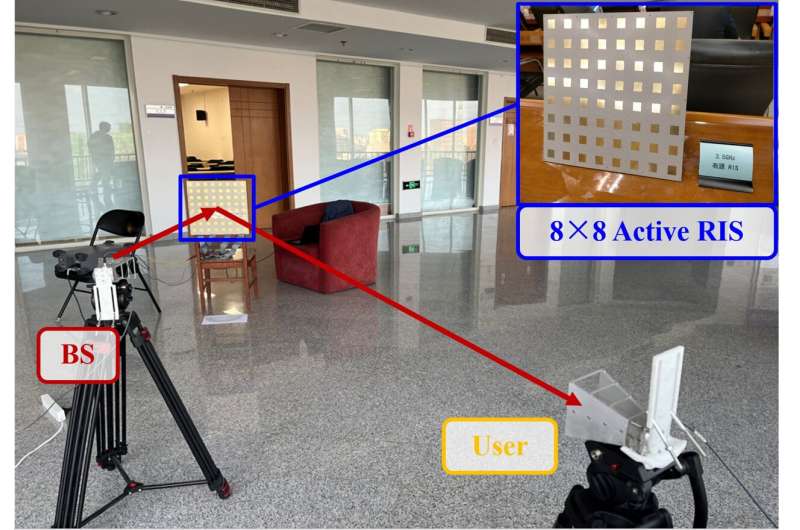
Reconfigurable intelligent surface (RIS) has become a promising technology in future 6G communications. Thanks to its high array gain, low cost, and low power consumption, RISs can improve spectral efficiency and reduce power consumption. The RISs widely studied in most existing works are usually passive RISs.
Specifically, a passive RIS comprises a large number of passive elements each being able to reflect the incident signal with a controllable phase shift. By properly adjusting to manipulate the signals reflected by the RIS elements to coherently add with the same phase at the receiver, a high array gain can be achieved.
“Unfortunately, in practice, this expected high capacity gain often cannot be realized in many communication scenarios,” said Prof. Linglong Dai, the leader of a wireless research team from Tsinghua University, “the reason for this negative result is the ‘multiplicative fading’ effect introduced by passive RISs.”
Prof. Dai pointed out that the equivalent path loss of the transmitter-RIS-receiver reflected link is the product (instead of the sum) of the path losses of the transmitter-RIS and RIS-receiver links, and thus it is thousands of times larger than that of the unobstructed direct link. Thereby, for an RIS to realize a noticeable capacity gain, thousands of RIS elements are required to compensate for this serious path loss.
To overcome this fundamental limitation, the research team, led by Prof. Dai, proposed the concept of active RISs in their recently published articles. “Unlike conventional passive RISs that reflect signals without amplification, active RISs can amplify the reflected signals via amplifiers integrated into their elements so as to compensate for the large path loss of RIS-aided links,” said Zijian Zhang, the team member who has worked on active RISs for several years.
To characterize the signal amplification and incorporate the noise introduced by the active components, the research team developed and verified the signal model of active RISs through the experimental measurements based on a fabricated active RIS element. Based on the verified signal model, they also analyzed the asymptotic performance of active RISs, and a joint transmit beamforming and reflect precoding scheme was proposed to maximize the sum-rate of an active RIS aided multi-user multiple-input single-output (MU-MISO) system.
Simulation results showed that, in a typical wireless system, passive RISs can realize only a limited sum-rate gain of 22%, while active RISs can achieve a significant sum-rate gain of 130%, thus overcoming the “multiplicative fading” effect.
Prof. Dai said that they also developed a 64-element active RIS aided wireless communication prototype, aiming to reveal the substantial capacity gain of active RISs in real-world system. By moving the user at different locations and dynamically configuring the phase shift of the active RIS, the research team obtain the experimental results of this prototype.
“Compared with the received power for the metal plate, the active RIS can always achieve a gain of about 10 dB,” said Zhang. “The data rate for the active RIS can hold at about 30 Mbps, while that for a metal plate with the same size only ranges from 1 Mbps to 2Mbps.”
Zhang explained that the beamforming at the active RIS can make the reflected beam with high array gain and reflection gain, while the metal plate can only reflect the incident signals randomly without in-phase combination or amplification, which finally validated the significant gain of active RISs.
The findings are published in the journal IEEE Transactions on Communications.
More information:
Zijian Zhang et al, Active RIS vs. Passive RIS: Which Will Prevail in 6G?, IEEE Transactions on Communications (2022). DOI: 10.1109/TCOMM.2022.3231893
Provided by
Tsinghua University Press
Citation:
Active RIS vs. passive RIS: Which will prevail in 6G? (2023, May 26)
retrieved 26 May 2023
from https://techxplore.com/news/2023-05-ris-passive-prevail-6g.html
This document is subject to copyright. Apart from any fair dealing for the purpose of private study or research, no
part may be reproduced without the written permission. The content is provided for information purposes only.
For all the latest Technology News Click Here
For the latest news and updates, follow us on Google News.
